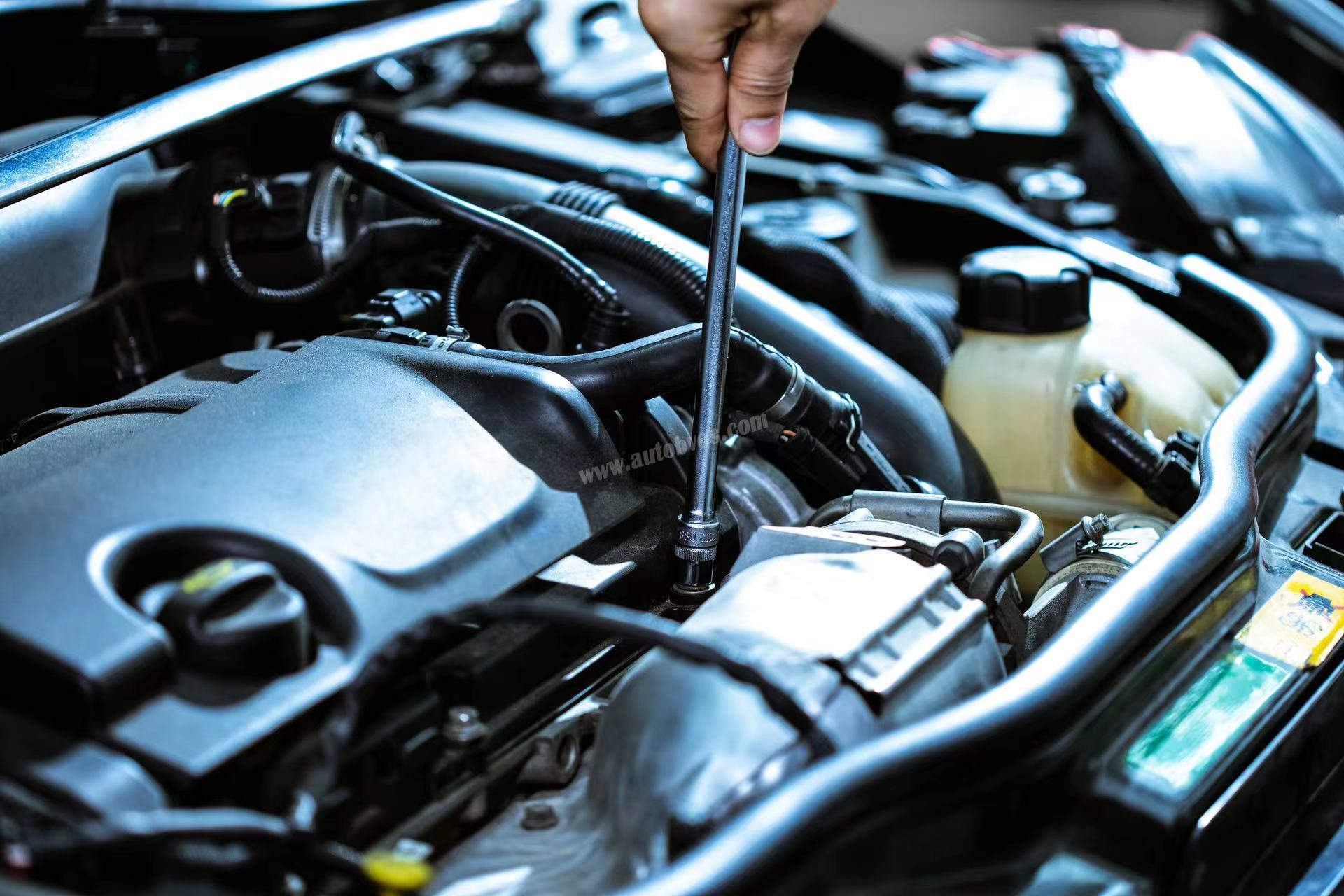
Look for application-specific needs in your owner’s manual. While many aspects of routine maintenance on your care are universal, there are some that may be specific to your car’s particular make, model, or year. Check in the owner’s manual for scheduled maintenance requirements to ensure you don’t miss any important ones.
Check the fluid reservoirs in the engine bay and add more fluid when needed. Your engine bay has plastic reservoirs for brake fluid, engine coolant, windshield washer fluid, and power steering fluid. The lower line on the reservoir is the “fill” point. Any time you see the fluid drop below that line, add more until it’s back up to the higher line, which is the “full” point
Change your oil every 3,000 miles. Once you hit the 3,000-mile mark, jack up the car and slide a container beneath the Oil Pan. Remove the drain bolt (the only bolt running into the Oil Pan) and allow the oil to drain out into the container. Then locate the oil filter and remove it it. Put a bit of oil on your finger and run it along the seal of the new filter, then screw it in place. Return the drain bolt to the Oil Pan once it has finished draining.
Swap out your air filter every year. The air filter prevents sand and debris from getting into your engine from outside. Most filters need to be replaced annually, though some aftermarket filters can be cleaned instead of replaced. Find the airbox at the end of the intake pipe that leads into the top of the engine. Release the 2 to 4 clips holding it closed and open the top to access the air filter.
Use the right octane fuel for your engine. The octane rating of fuel is a measurement of the fuel’s stability under pressure. High compression or forced induction engines (turbocharged or supercharged engines) require a higher octane fuel than most other vehicles. Using a lower octane fuel could cause damage to the engine and create real problems in the future.
Install a new fuel filter every 40,000 miles. The fuel filter blocks the passage of dirt and sediment from your fuel tank to the engine itself. To replace the filter, locate it along the fuel line running from the gas tank to the front of the car. It will look like a cylinder with a nozzle coming out of the front and back. Place a container beneath it to catch any leaking fuel, then use a flat head screwdriver to pop off the clips holding the fuel lines on the nozzles.
Drain and flush your coolant system once a year. Jack up the vehicle and place a container beneath the radiator’s drain plug. Open the drain plug and allow all of the coolant to pour out. Then close the drain plug again. Open the radiator cap at the top of the radiator and fill it with water, then close the cap and drain it again. Then refill the radiator with the right coolant for your vehicle.
Clean your radiator with bug remover when it gets dirty. Spray radiator bug remover onto the radiator and allow it to sit for a few minutes. Don’t touch or scrub the radiator itself. Touching it may bend the blades or result in injury since they are sharp. Instead, allow the bug remover to set for around 2 minutes and then spray it off with a hose.
Replace your brake pads every 20,000 miles. Failing brakes can be extremely dangerous. If you think your brakes may be failing, have them serviced immediately. To do it yourself, loosen the car’s lug nuts and then jack the vehicle up. Support the car with jack stands then remove the lug nuts the rest of the way. Locate the brake caliper (it looks like a vice clamped onto the circular rotor) and remove the 2 bolts that hold it in place. Slide it off the rotor and use a C-clamp to compress the piston back into the caliper.
Change out worn or damaged belts. Check your belts for signs of cracking or advanced wear like rub marks. Then, check the Belt Tensioner to ensure it hasn’t stretched out. If you spot signs of damage or the belt doesn’t have enough tension, replace it. Insert a breaker bar into the opening on the auto-tensioner pulley and turn it counterclockwise if your car is equipped with one, otherwise, loosen the 2 bolts holding the alternator on the bracket to relieve the tension on the belt. Slide it off of all the pulleys then put the new on one in its place.
Replace cracked or damaged hoses. With the hood open, look over the rubber hoses in the engine bay for any signs of damage. If you spot a damaged hose, place a drain pan beneath it and loosen the hose clamps with pliers or a screwdriver. Remove the hose and take it to your local auto parts store to get a replacement one of the correct length and interior diameter.
Clean your battery contacts once a year. The connection for your battery can sometimes get corroded or covered in grime, making it harder for the electrical current to flow through the car’s system. Use the correct sized wrench or socket and ratchet to loosen the bolt holding the negative (-) cable on the battery, then slide the cable off. Then do the same with the positive (+) cable. Add 1 tablespoon (13.8 g) of baking soda to 1 cup (240 ml) of water, then dip a steel toothbrush in the mixture.
Test your lights and replace any bulbs that have blown out. Ask a friend to stand in front of your car while you turn on your headlight low beams and then high beams. Then test the left and right turn signals. Next, ask your friend to move to the back of the car while you test your brake lights and each turn signal once again.
Check and replace fuses as they blow out. If some lights go out in the interior of your car, chances are good that it’s a blown fuse. Locate the 2 fuse boxes in your car. One is usually near your left knee when sitting in the driver’s seat and the other is often found inside the engine bay. Use the diagram on the fuse box lids to find the right fuse for the lights that went out, then remove that fuse and replace it with one rated for the same electrical amperage.
Replace your spark plugs every 30,000 miles. Open the hood and locate the spark plug wires running into the top of the engine. Grip the closest wire to you low at its base and pull it up to unplug it from the spark plug. Use a spark plug socket and a ratchet to unscrew the spark plug and pull it up and out of the engine.
Use an OBD-II scanner to check and clear error codes. If your check engine light comes on, turn the vehicle off and plug an OBD-II scanner into the rounded trapezoid-shaped port located beneath the steering wheel. Turn the key in the ignition to “accessory” and turn on the code scanner to see what set off the check engine light.
Check your tire pressure and add air when needed. Look at the side of your tire and find where it says, “max pressure” followed by a number and the letters “PSI.” Then, unscrew the cap on the tire and press a tire gauge onto the nozzle to see what the pressure inside the tire actually is. If it’s lower than a few PSI (pounds per square inch) below the maximum rating, use an air compressor to add air to the tire until it’s within a few PSI of the max.
Use a penny to check the tread on your tires for wear. You can use a penny to assess the level of tread left on your tires quickly. Turn the penny upside down and hold it so you can clearly see Lincoln’s head. Insert the penny into the groove between the tire treads and see how much of Lincoln’s head you can still see clearly.
Rotate your tires every 5,000 miles. Make sure the tread on your tires wear evenly by swapping them on the car periodically. Jack the car up and support its weight with jack stands, then take the wheel and tire from the rear of the car and install on the front. Install what was the front wheel onto the rear. Then do the same on the other side.
Swap out your windshield wipers when they start to streak. Windshield wipers are an important piece of safety gear for your car. When they begin to make streaks on your windshield, it means they need to be replaced. On most cars, you can grab the wiper and pull it out away from the windshield. Then turn the wiper so it is perpendicular to the wiper arm and slide it down off the arm’s hook to remove it.
Wax your car to protect the paint twice per year. The paint on your car does more than just keep it looking nice. It also prevents rusting that can lead to expensive repairs. Wash your car and then apply a fresh layer of wax to the paint every 6 months to give it a bit of added protection and stave off any potential rusting that could develop.
Contact: Mr. Alex
Phone: +8613751750509
E-mail: [email protected]
Whatsapp:+8613751750509
Add: 710 No. Sanyuanli Avenue. Baiyun District, Guangzhou,China
We chat
